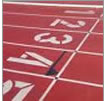Sprint or Endurance - TN
Teacher Notes

Why we like this activity ….
To keep students engaged and interested, we feel it is important to provide them with contexts that are up to date and relevant. Here we provide you with some websites that will permit you to keep them continually up to date and relevant to your students:
![]() International Association of Athletics Federations Statistics webpages,
International Association of Athletics Federations Statistics webpages, ![]() Football player statistics.
Football player statistics.
Wikipedia is also a good source of stats if you have a list of athletes names to search for.
Many young people dream of being sports stars. This provides a weblink and real information on what that might take! This engaging with student desires hopefully provides a "hook" to encourage student motivation.
How this activity can be used ….
The images can be cut and pasted into whatever presentation software your mathematics department uses: promethean, smartboards, powerpoint, easiteach etc. so that you can construct a "sprinters heights" stem&leaf with the students. The method for teaching students the mechanics of drawing a stem and leaf diagram are left to each teacher's personal preference and style. Students use the worksheet to keep good notes and all their work in one place. The questions are sufficient in number for students to make some real and surprising, or at least interesting, conclusions as to physiognomic differences between aspiring endurance runners' and sprinters' heights and weights (we find textbooks can put students off because a long list of questions can seem intimidating, both in terms of difficulty and in terms of "no end in sight"). A real context helps to clarify how we interpret interquartile ranges, medians e.g. the upper quartile shows us that 25% sprinters are taller than the tallest endurance runner!
This resource can be used as a stand alone resource to teach stem and leaf diagrams, or serve as the driver to a whole statistics module. Students can use a variety of statistical techniques to analyse this data further (cumulative frequency diagrams, scatter graphs, grouped frequency tables, mean, standard deviation etc.) and produce a full written report. They can write their report in word, publisher, powerpoint etc., or use a wikispace to allow the embedding of youtube videos to illustrate their findings and make it available on the school website for other year groups and classes to view.
Some of the athletes in this list did not actually compete in the 2008 olympics! I have included them because they are "hall of fame" standard athletes, and therefore good examples of "ideal" heights and weights for their chosen events e.g. Leroy Burrell, Maurice Greene, Donovan Bailey, Morceli Noureddine, Mourhit Mohammed (athletes in the tail end of each list) etc. The age I used was the age they were when they competed in their last olympics in which they earnt either a gold, silver or bronze medal.
What to expect when using this activity – from our experience
The success of the activity is to an extent determinant on how well you manage to communicate to students how this analysis can help them understand something about the selection procedures used in modern sport. And this in turn may well depend on how well you manage to get a discussion going about student’s own interests in different sports and, based on their experience playing or watching, what they think the different body types for different sports are. Use youtube to show them some clips of sprinters and endurance runners at the Olympics or something about the Australian Institute. There is a sport for every body type!
![]() 10 000m Commonwealth men's final
10 000m Commonwealth men's final
Alternatively, you can find videos from youtube of budding young athletes talking about their dreams of one day making it big (like the one provided on the activity page) or perhaps even someone from within your class has a video of themselves competing? .
Get your class talking about sports they enjoy!
Get them personally investing in finding out the results of the analysis and how they can use statistical skills to inform them about the world they live in to help guide them in their life choices.
